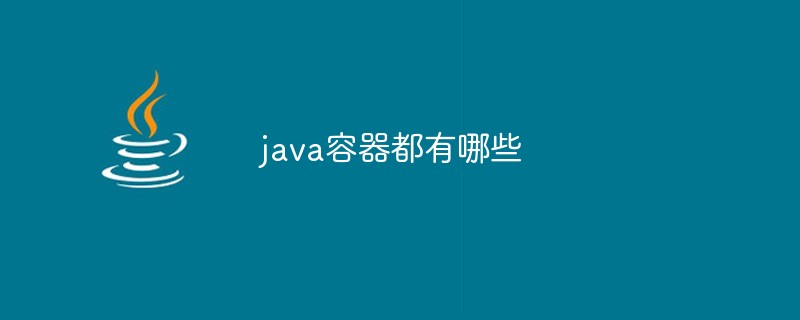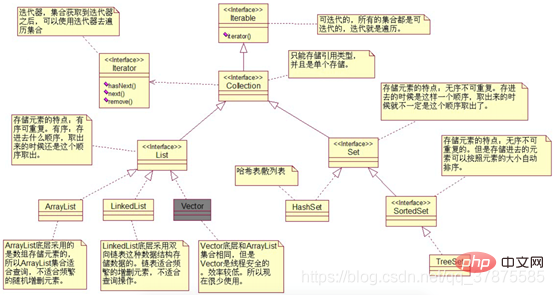What are the java containers?
Java containers include: ArrayList, LinkedList, Vector, HashSet, LinkedHashSet, TreeSet, LinkedHashMap, TreeMap, ConcurrentHashMap, Hashtable, etc.

The operating environment of this tutorial: windows7 system, java8 version, DELL G3 computer.
What is a container?
Container refers to a basic device used to hold materials and is mainly a shell.
The purpose of the Java container class library is to "save objects". Excerpted from: "Thinking in Java".
The Java collection class is a particularly useful tool class that can be used to store a varying number of objects and can implement commonly used data structures, such as stacks, queues, etc. A Java collection is like a container that can "throw" multiple objects (actually references to objects, but commonly called objects) into the container. Excerpted from: "Crazy Java Lecture Notes".
Containers in Java are also called collections, which are objects specially used to manage objects. This is what I am talking about.
What are Java containers?
Java containers are divided into two categories: Collection and Map, and there are many subclasses under them. The following is the inheritance system of Collection and Map:


- Collection
- List
- ArrayList
- LinkedList
- Vector
- Stack
Set- HashSet
- LinkedHashSet
- TreeSet
Map- HashMap
- LinkedHashMap
TreeMap- ConcurrentHashMap
- Hashtable
##What is the difference between ArrayList and LinkList?
ArrayList (array structure):
- Advantages: get and set calls take constant time, that is, the query Fast
- Disadvantages: The insertion of new items and the deletion of existing items are expensive, that is, the speed of addition and deletion is slow
:
- Advantages: The cost of inserting new items and deleting existing items is very small, that is, adding and deleting are fast
- Disadvantages: Calling get and set is expensive and not suitable for querying
The difference between List, Set and Map What is it? The difference between List, Set, and Map is mainly reflected in two aspects: whether the elements are ordered and whether duplicate elements are allowed.
The differences between the three are as follows:

What is the difference between HashMap and Hashtable?
- Storage: HashMap operates with null key and value, while Hashtable does not allow this.
- Thread safety: Hashtable is thread-safe, while HashMap is not thread-safe.
- Recommended use: As you can see in the class annotation of Hashtable, Hashtable is a reserved class and is not recommended for use. It is recommended to use HashMap instead in a single-threaded environment. If multi-threading is required, use ConcurrentHashMap substitute.
What is the difference between Comparable and Comparator? Comparable interface
- Implementing the Comparable interface class indicates that objects of this type can be compared in size. Such objects that can be compared in size allow for natural sorting.
- Comparator interface
- The comparator is used to compare any properties of objects.
- When sorting, you can achieve arbitrary attribute sorting by specifying an attribute comparator.
- When sorting, the Comparable interface is used for natural sorting, while the Comparator interface is used for custom sorting. Custom sorting is more flexible, convenient and commonly used.
Recommended related video tutorials:
The above is the detailed content of What are the java containers?. For more information, please follow other related articles on the PHP Chinese website!

Hot AI Tools

Undresser.AI Undress
AI-powered app for creating realistic nude photos

AI Clothes Remover
Online AI tool for removing clothes from photos.

Undress AI Tool
Undress images for free

Clothoff.io
AI clothes remover

Video Face Swap
Swap faces in any video effortlessly with our completely free AI face swap tool!

Hot Article

Hot Tools

Notepad++7.3.1
Easy-to-use and free code editor

SublimeText3 Chinese version
Chinese version, very easy to use

Zend Studio 13.0.1
Powerful PHP integrated development environment

Dreamweaver CS6
Visual web development tools

SublimeText3 Mac version
God-level code editing software (SublimeText3)

Hot Topics
 1386
1386
 52
52
 Perfect Number in Java
Aug 30, 2024 pm 04:28 PM
Perfect Number in Java
Aug 30, 2024 pm 04:28 PM
Guide to Perfect Number in Java. Here we discuss the Definition, How to check Perfect number in Java?, examples with code implementation.
 Weka in Java
Aug 30, 2024 pm 04:28 PM
Weka in Java
Aug 30, 2024 pm 04:28 PM
Guide to Weka in Java. Here we discuss the Introduction, how to use weka java, the type of platform, and advantages with examples.
 Smith Number in Java
Aug 30, 2024 pm 04:28 PM
Smith Number in Java
Aug 30, 2024 pm 04:28 PM
Guide to Smith Number in Java. Here we discuss the Definition, How to check smith number in Java? example with code implementation.
 Java Spring Interview Questions
Aug 30, 2024 pm 04:29 PM
Java Spring Interview Questions
Aug 30, 2024 pm 04:29 PM
In this article, we have kept the most asked Java Spring Interview Questions with their detailed answers. So that you can crack the interview.
 Break or return from Java 8 stream forEach?
Feb 07, 2025 pm 12:09 PM
Break or return from Java 8 stream forEach?
Feb 07, 2025 pm 12:09 PM
Java 8 introduces the Stream API, providing a powerful and expressive way to process data collections. However, a common question when using Stream is: How to break or return from a forEach operation? Traditional loops allow for early interruption or return, but Stream's forEach method does not directly support this method. This article will explain the reasons and explore alternative methods for implementing premature termination in Stream processing systems. Further reading: Java Stream API improvements Understand Stream forEach The forEach method is a terminal operation that performs one operation on each element in the Stream. Its design intention is
 TimeStamp to Date in Java
Aug 30, 2024 pm 04:28 PM
TimeStamp to Date in Java
Aug 30, 2024 pm 04:28 PM
Guide to TimeStamp to Date in Java. Here we also discuss the introduction and how to convert timestamp to date in java along with examples.
 Java Program to Find the Volume of Capsule
Feb 07, 2025 am 11:37 AM
Java Program to Find the Volume of Capsule
Feb 07, 2025 am 11:37 AM
Capsules are three-dimensional geometric figures, composed of a cylinder and a hemisphere at both ends. The volume of the capsule can be calculated by adding the volume of the cylinder and the volume of the hemisphere at both ends. This tutorial will discuss how to calculate the volume of a given capsule in Java using different methods. Capsule volume formula The formula for capsule volume is as follows: Capsule volume = Cylindrical volume Volume Two hemisphere volume in, r: The radius of the hemisphere. h: The height of the cylinder (excluding the hemisphere). Example 1 enter Radius = 5 units Height = 10 units Output Volume = 1570.8 cubic units explain Calculate volume using formula: Volume = π × r2 × h (4
 Create the Future: Java Programming for Absolute Beginners
Oct 13, 2024 pm 01:32 PM
Create the Future: Java Programming for Absolute Beginners
Oct 13, 2024 pm 01:32 PM
Java is a popular programming language that can be learned by both beginners and experienced developers. This tutorial starts with basic concepts and progresses through advanced topics. After installing the Java Development Kit, you can practice programming by creating a simple "Hello, World!" program. After you understand the code, use the command prompt to compile and run the program, and "Hello, World!" will be output on the console. Learning Java starts your programming journey, and as your mastery deepens, you can create more complex applications.




